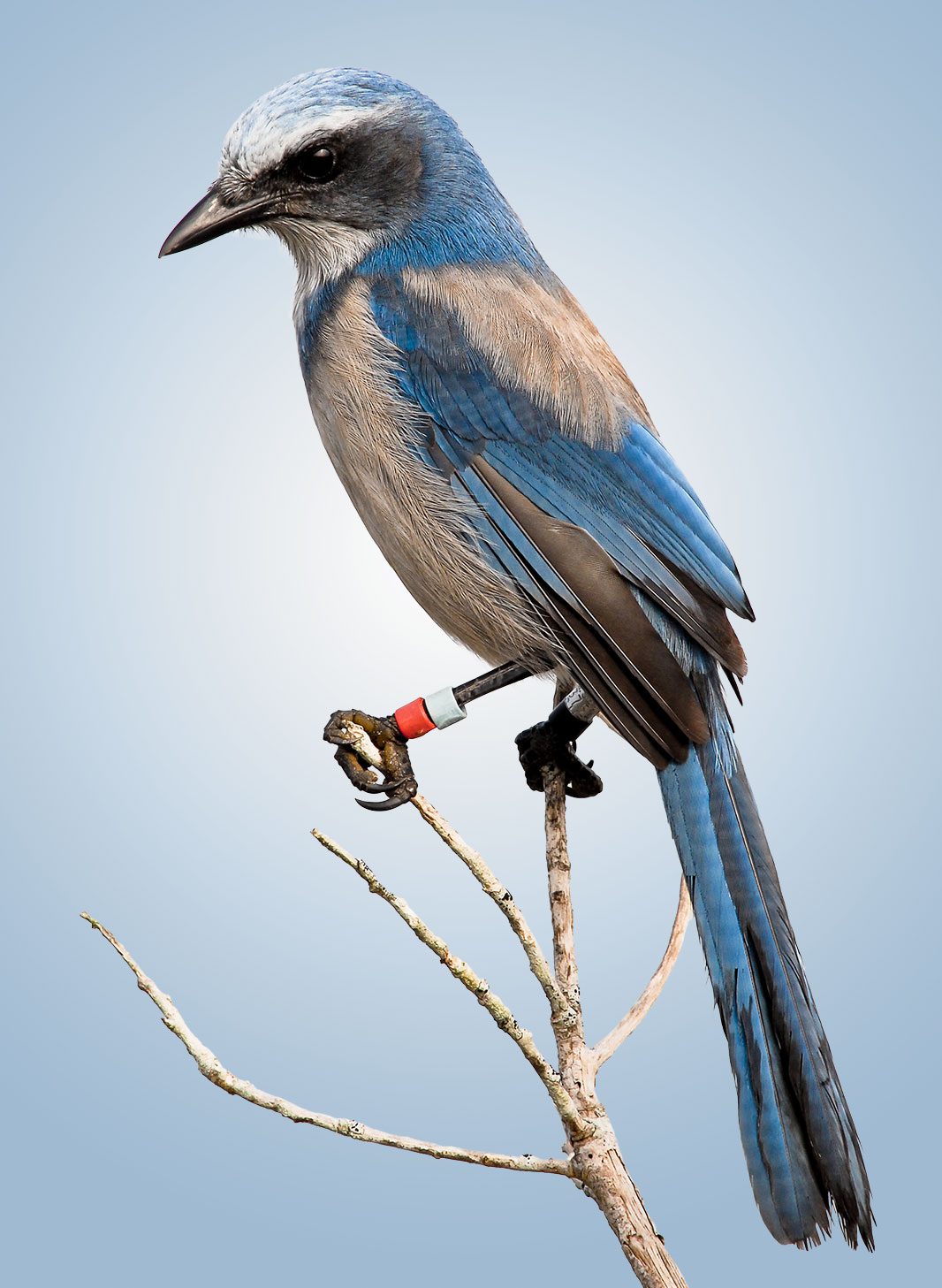View from Sapsucker Woods: 50 Years of Florida Scrub-Jay Studies Show Value of Long-Term Research
By John Fitzpatrick
June 17, 2019

From the Summer 2019 issue of Living Bird magazine. Subscribe now.
Fifty years ago this spring, Cornell alum Glen Woolfenden ’53 put plastic color leg bands on a few Florida Scrub-Jays at Archbold Biological Station in central Florida. He was intrigued by the cooperative social behavior at the nests of these little-studied jays (older siblings from the previous year’s breeding season stick around to help parents at the nest), and he affixed the leg bands to identify each individual member of seven different family groups.
The color combinations on those leg bands gave rise to pedestrian-sounding names—Red-dash-White-Silver, Blue-dash-Blue-Silver, and so on—that remain vital five decades later even though the jays themselves are long gone. For understanding the complex private lives of individual jays, plus the social and genetic histories of their descendants, those dry band combinations are as informative as if the birds had been called Scarlet Quicksilver, and Indigo Sky.
Our dear friend Glen passed away in 2007, but the long-term population study he pioneered thrives half a century later. I joined as a college intern in 1972, and in 1990 I hired Glen’s PhD student, Reed Bowman, to start a comparative study in a nearby, rapidly growing residential development. Today, Bowman oversees the entire project as head of Archbold’s avian ecology lab. Over five decades, cohorts of interns and graduate students have honed their skills in field ecology by conducting monthly censuses, finding and monitoring every nest, mapping every territory, counting thousands of acorns, and—key to the workings of a long-term study—color-banding and blood-sampling every nestling and immigrant Florida Scrub-Jay that moves into a local population. Today, dozens of alumni/ae scientists from long-term studies at Archbold Biological Station are practicing ecologists and conservation biologists around the world.
Can we possibly still learn new things about Florida Scrub-Jays after 50 years of study and hundreds of publications? This is the most common question we receive about our work, and the answer is a resounding YES. Indeed, the singular importance of long-term ecological research is such that the U.S. National Science Foundation supports two programs bearing these very words: the Long Term Ecological Research program generously supports a network of research facilities in key natural and working-landscape habitats around the world, while the Long Term Research in Environmental Biology program provides baseline support for investigators committed to studying their systems over decades.
Decades-scale studies of animal and plant systems yield unrivaled perspectives for ecology, evolutionary biology, and conservation. In our case, Florida Scrub-Jays can live for up to 15 years, so decades are required to accumulate enough data to analyze how and why individuals vary in their success at contributing offspring to future generations. It also takes decades to document experimentally the essential importance of the natural wildfire cycle for Florida Scrub-Jay conservation. Moreover, new technologies, such as genomics, keep evolving that allow us to dig deeper into such questions, and to train—and be trained by—new students in their applications. Even as I write this essay, Cornell graduate student Young Ha Suh is pilot-testing tiny radio-frequency tags (yet another new technology) to resolve long-standing mysteries involving social networks and dispersal prospecting by prebreeding jays. If her work pans out, these tags are likely to launch a whole new generation of studies, eventually accumulating new decades of data on day-by-day movements of individuals.
As human influences continue to affect the natural fabric of our planet, the pivotal importance of long-term ecological studies for understanding and moderating our impacts will only grow. Our commitment to Glen is that the study he began five decades ago shall live on and be passed from one generation of scientist to the next, just as he did.


All About Birds is a free resource
Available for everyone,
funded by donors like you





